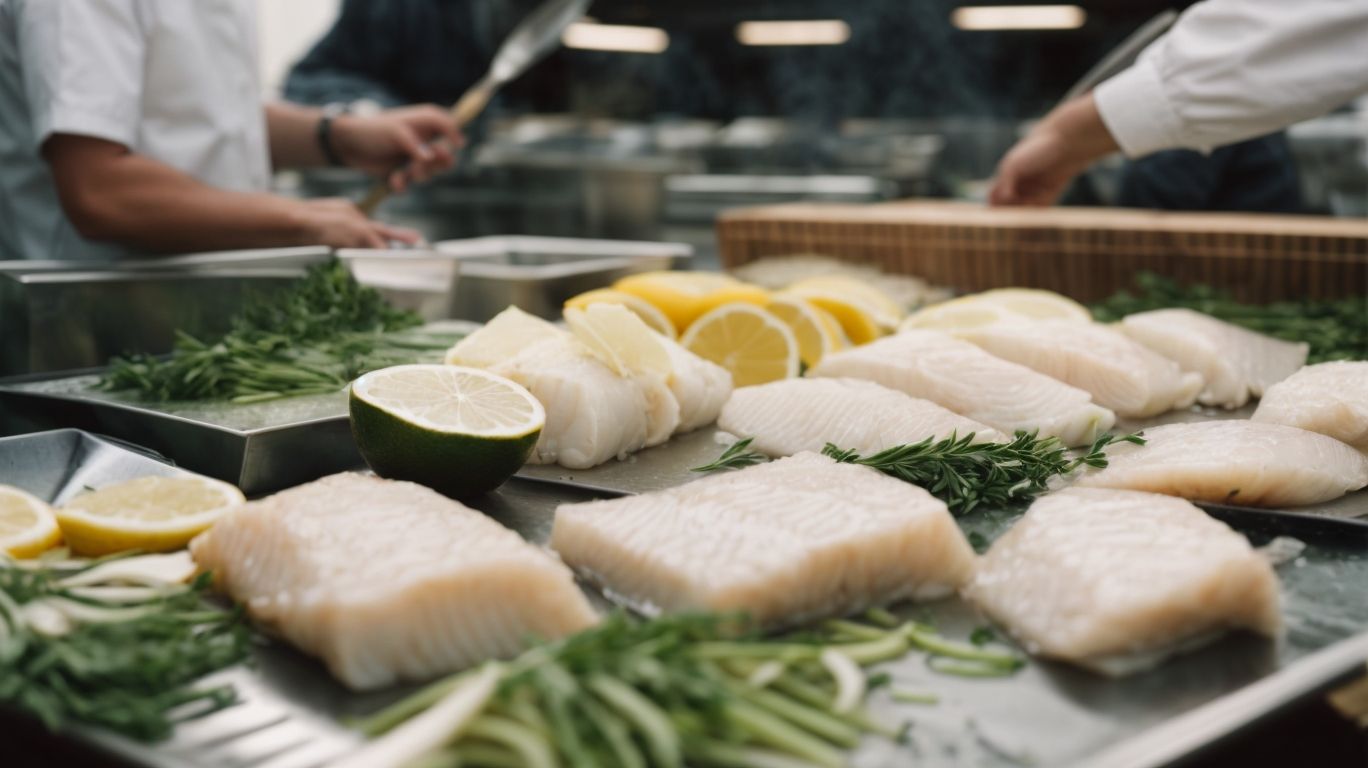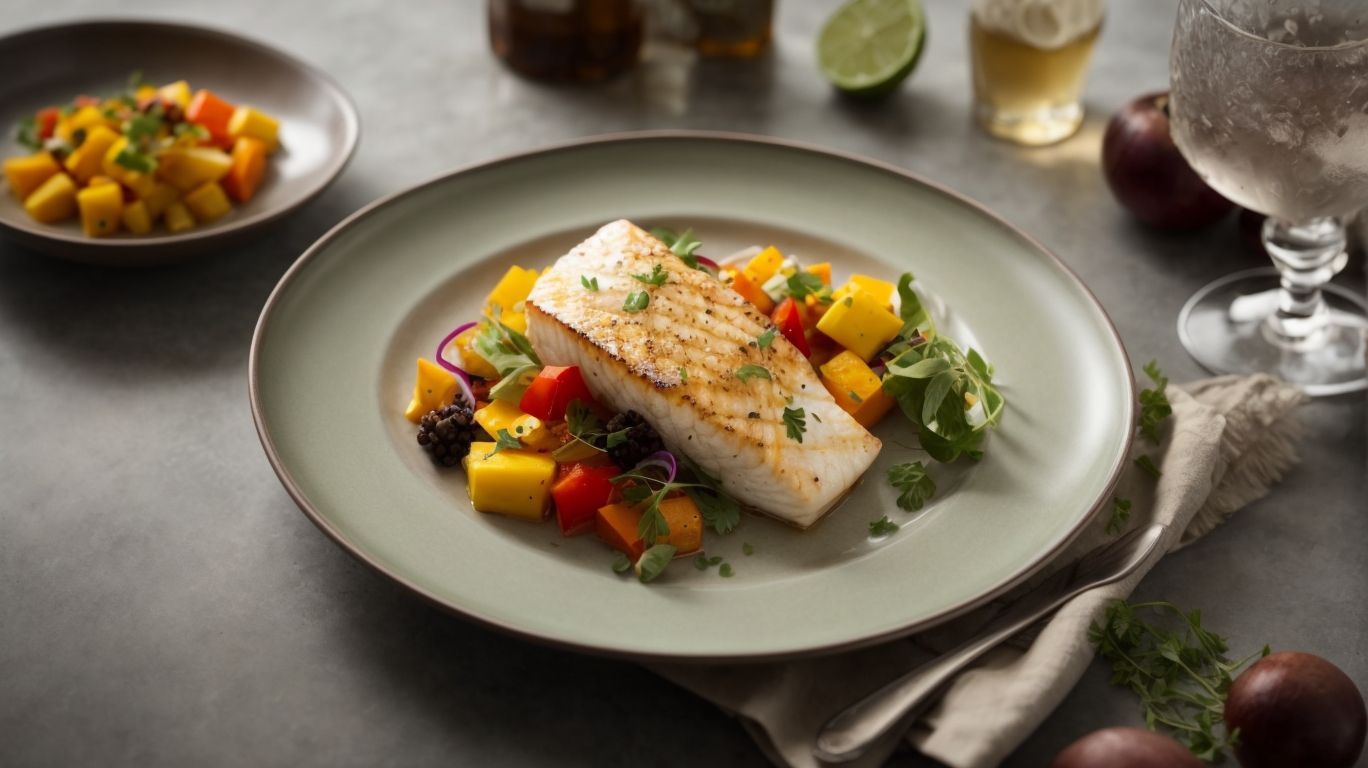How to Cook Halibut?
Are you looking to elevate your seafood cooking skills?
We will explore everything you need to know about halibut, from its nutritional benefits to the best ways to buy and prepare it.
Learn about various cooking methods for grilling, baking, or pan-searing halibut to create delicious dishes.
Discover tips on seasoning, flavoring, serving suggestions, and more to enhance your culinary skills with halibut.
Dive into the world of halibut and take your cooking skills to the next level!
Key Takeaways:
About Halibut
Halibut, known for its delicate flavor and firm texture, is a popular white fish choice for culinary enthusiasts.
One of the unique characteristics of halibut is its ability to hold up well to a variety of cooking methods, making it versatile in the kitchen. Whether grilled, baked, or pan-seared, halibut retains its moistness and flavor, making it a go-to option for many seafood lovers.
Its mild taste also makes it a perfect canvas for a wide range of flavor profiles. From simple lemon and herb seasoning to more complex sauces like a creamy dill or citrus glaze, halibut adapts wonderfully to different culinary creations.
What is Halibut?
Halibut, a type of versatile white fish, is prized for its mild flavor and flaky texture, making it a versatile ingredient in various culinary creations.
Known for its firm and meaty flesh, halibut lends itself well to a myriad of cooking techniques, from grilling and baking to pan-searing and broiling. Its delicate yet robust flavor pairs beautifully with fresh herbs and zesty citrus, allowing for a wide range of seasoning possibilities. Whether you prefer a simple lemon butter sauce or a more elaborate herb-infused marinade, halibut adapts to diverse flavor profiles with ease. The versatility of halibut extends beyond traditional seafood dishes, as it can also be incorporated into salads, tacos, and pasta for a creative twist on classic recipes.
What Are the Nutritional Benefits of Halibut?
Halibut is a nutrient-rich fish that offers a good source of protein, omega-3 fatty acids, and essential vitamins like B12 and D.
Protein is crucial for building and repairing tissues in the body, and halibut provides a lean protein source that can support muscle growth and satiety. The omega-3 fatty acids found in halibut are beneficial for heart health, reducing inflammation, and supporting brain function. The vitamin B12 in halibut plays a vital role in red blood cell formation and neurological function, while vitamin D helps with calcium absorption, promoting strong and healthy bones.
How to Buy the Best Halibut?

Credits: Poormet.Com – Robert Garcia
Selecting the best halibut involves considering key factors like freshness, appearance, and odor to ensure a premium seafood purchase.
Regarding freshness, look for halibut that has a firm texture and a mild aroma of the sea. Avoid fish that has a strong fishy smell or appears mushy. Fresh halibut should have clear, bright eyes and shiny, moist flesh.
- For appearance, choose fillets or steaks that are translucent, not discolored, and free from any slimy residue.
- Check for any discoloration or dark spots, as these could indicate the fish is not in optimal condition.
Remember, the best halibut will have a fresh ocean scent and a slightly sweet taste, ensuring a delicious and satisfying meal.
What to Look for When Buying Fresh Halibut?
When purchasing fresh halibut, look for clear eyes, firm flesh, and a mild sea scent to guarantee the best quality for your culinary creations.
Visual cues are crucial in identifying the freshness of halibut. Opt for fish with bright, clear eyes that are not sunken or cloudy, as this indicates the fish is recently caught. The flesh should be firm to the touch, bouncing back when pressed lightly, a sign of a newly caught halibut. A mild sea scent that is fresh and not overpowering is a key indicator of the fish’s quality.
What to Consider When Buying Frozen Halibut?
When selecting frozen halibut, opt for vacuum-sealed packages with minimal ice crystals to preserve the fish’s flavor and texture effectively.
Choosing the right packaging is crucial as it ensures that the halibut remains fresh and free from freezer burn. Vacuum-sealed packages help maintain the fish’s quality by preventing exposure to air and moisture, preserving its natural taste.
Ensure that the packaging is intact and free from any tears or damage, as this can affect the halibut’s quality. Minimal presence of ice crystals indicates that the fish has been properly frozen, reducing the risk of texture deterioration.
When storing frozen halibut, make sure to keep it in the coldest part of the freezer to maintain its freshness. Proper storage helps prevent flavor loss and maintains the fish’s overall quality for a longer period.
Preparation of Halibut
Properly preparing halibut involves thawing frozen fillets and cleaning them thoroughly before cooking to enhance the dish’s flavors.
To thaw frozen halibut fillets, place them in the refrigerator overnight to slowly defrost. This gradual process helps maintain the fish’s texture and flavor. Once thawed, rinse the fillets under cold water to remove any remaining ice crystals. Use a paper towel to pat them dry before proceeding with the cleaning process. When cleaning, check for any remaining bones or skin that may have been missed during the filleting process. Removing these parts ensures a smoother dining experience without unexpected surprises during consumption.
How to Thaw Frozen Halibut?
Thawing frozen halibut safely involves either refrigerating the fillets overnight or using a cold water bath to defrost them gradually.
When refrigerating the halibut fillets, place them in a covered container or a sealed plastic bag to prevent any potential cross-contamination.
Thawing in the refrigerator is a convenient and safe method that maintains the quality of the fish by keeping it at a consistent, low temperature. On the other hand, if you opt for a cold water bath, seal the fillets securely in a leak-proof bag to avoid water absorption. Change the water every 30 minutes to ensure a constant cold environment and speed up the defrosting process.
How to Clean and Fillet Halibut?
Cleaning and filleting halibut requires removing the skin, bones, and any dark flesh to ensure a pristine fillet ready for cooking.
Start by laying the halibut flat on a clean cutting board with the skin side down. Using a sharp fillet knife, gently make a horizontal incision just behind the head to separate the head from the body. Next, run the knife along the backbone, beginning from the head side down towards the tail, keeping as close to the bones as possible to maximize meat yield. Carefully cut along the rib bones to detach the fillet, taking care to avoid any wastage.
Once the fillet is removed, inspect it for any remaining bones with your fingers or a pair of fish tweezers. Ensure all pin bones are completely removed to prevent any choking hazards when consuming. Trim off any dark meat or bloodline present along the center of the fillet as it can have a fishier taste.
Cooking Methods for Halibut
Halibut can be cooked using various methods such as grilling, baking, pan-searing, poaching, steaming, broiling, and frying to achieve a range of delicious dishes.
Grilling halibut is a popular method that imparts a smoky flavor and beautiful grill marks. Ensure the grill is hot, lightly oil the fish, and cook for a few minutes per side until the flesh is opaque and flaky.
Baking halibut is a gentle approach, perfect for preserving moisture. Season the fish, place it in a preheated oven, and bake until it easily flakes with a fork.
Pan-searing halibut creates a crispy exterior while keeping the inside moist. Heat oil in a pan, sear the fish until golden brown, then finish in the oven for even cooking.
Grilling Halibut
Grilling halibut imparts a smoky flavor and beautiful grill marks, enhancing the fish’s natural taste with a touch of charred goodness.
Before grilling halibut, it’s crucial to ensure your grill is preheated to the right temperature to prevent sticking. Lightly oil the grates to create a non-stick surface for the fish and maintain moist flesh. Halibut fillets, typically around 1 inch thick, need approximately 4-6 minutes per side on a medium-high heat grill. To enhance the flavor profile, consider seasoning the fish with a blend of fresh herbs like dill and parsley,
- garlic powder
- lemon zest
- paprika
. Achieving a perfect sear on the halibut requires patience and a watchful eye to control the cooking temperature.
Baking Halibut
Baking halibut in the oven with herbs and lemon creates a moist and flavorful dish that showcases the fish’s delicate taste and texture.
Before placing the halibut in the oven, it’s crucial to season it generously with salt, pepper, and any preferred herbs such as dill or parsley. This not only enhances the natural flavors of the fish but also adds a delightful aroma that will fill your kitchen as it bakes.
Preheat your oven to 400°F (200°C) for optimal cooking temperature. Arrange the seasoned halibut fillets on a baking dish lined with parchment paper to prevent sticking and ensure easy cleanup. Bake the halibut for approximately 15-20 minutes, depending on the thickness of the fillets, until the fish is opaque and flakes easily with a fork.
Pan-searing Halibut
Pan-searing halibut in a hot skillet results in crispy skin and tender flesh, offering a restaurant-quality dish with minimal effort.
Regarding choosing the right skillet for pan-searing, opt for a heavy-bottomed pan like cast iron or stainless steel. These materials distribute heat evenly, ensuring that the halibut cooks uniformly.
Before placing the fish in the skillet, make sure it is thoroughly dried and seasoned to enhance its natural flavors. When searing, resist the temptation to move the fish around too much; allow it to develop a golden crust. Searing at high heat locks in juices for a succulent finish.
For added flavor, consider incorporating herbs, garlic, or a splash of white wine to elevate the dish.
Poaching Halibut
Poaching halibut gently in flavored broth or wine yields a delicate and moist fish dish that highlights the fish’s natural flavors.
When poaching halibut, it’s essential to select a poaching liquid that complements the delicate taste of the fish. Common choices include vegetable or chicken broth, white wine, lemon-infused water, or a mixture of aromatics such as bay leaves, peppercorns, and onions.
Cooking times for poaching halibut can vary depending on the thickness of the fish fillets, but a general rule of thumb is to simmer the fish gently in the poaching liquid for 8-10 minutes per inch of thickness. It’s crucial not to overcook the halibut to maintain its tender texture.
For an extra layer of flavor, infuse the poaching liquid with herbs like dill, thyme, or parsley, along with citrus zest or slices. These additions will impart a subtle but delightful taste to the poached halibut without overpowering its natural sweetness.
Steaming Halibut
Steaming halibut preserves its moisture and tenderness, offering a light and healthy cooking method that retains the fish’s natural taste.
When preparing to steam halibut, one of the most crucial aspects is selecting the right equipment. A steamer basket or steaming rack placed in a pot with a tight-fitting lid works well for this purpose. This setup allows the fish to cook evenly as the steam circulates around it. As for seasoning options, you can keep it simple with lemon, herbs like dill or parsley, and a sprinkle of salt and pepper to enhance the fish’s delicate flavor.
When serving steamed halibut, consider accompanying it with
- steamed vegetables for a wholesome meal
- rice or quinoa for a satisfying base
These sides complement the fish without overpowering its taste, creating a well-balanced dish. The lightness of steamed halibut pairs well with a crisp white wine or a tangy citrus-infused drink for a delightful dining experience.
Broiling Halibut
Broiling halibut in the oven caramelizes its surface and enhances its flavors, creating a quick and flavorful seafood dish.
When broiling halibut, it is essential to preheat the broiler to ensure even cooking. Adjust the rack position in the oven to get the desired level of heat exposure for the fish. For a perfectly broiled halibut, aim for a golden-brown crust without overcooking the tender flesh inside. Season the halibut with a sprinkle of salt, a squeeze of lemon juice, and a touch of olive oil before placing it under the broiler. Keep a close eye on the cooking process to prevent burning and achieve the ideal texture. The broiled halibut can be served with fresh herbs or a delicate sauce to complement its savory flavor profile.
Frying Halibut
Frying halibut in a skillet with a crispy coating offers a delightful crunch and succulent interior, ideal for creating indulgent seafood dishes.
When preparing to fry halibut, it’s crucial to season the fish generously to enhance its flavors. Some popular breading methods for halibut include using a mixture of flour, breadcrumbs, and seasonings like paprika or garlic powder. Regarding frying, ensure the oil is heated to around 350-375°F to achieve a crispy exterior without overcooking the delicate fish.
Once your halibut is cooked to golden perfection, serve it with a squeeze of lemon juice for a refreshing zest or pair it with a tangy tartar sauce. Accompany your fried halibut with a side of crispy fries or a fresh salad to create a well-rounded and satisfying meal.
Seasoning and Flavoring Halibut
Enhancing the natural flavor of halibut involves using a blend of garlic, parsley, lemon, and olive oil to create a simple yet delicious seasoning profile.
When seasoning this delicate white fish, consider a harmonious combination of herbs and spices like dill, thyme, or even a hint of paprika. The key is to strike a balance between enhancing the fish’s taste and not overpowering it. For a zesty twist, a marinade of lemongrass, ginger, and soy sauce can add an Asian-inspired flair to your halibut dish.
What Spices and Herbs Work Well with Halibut?
Aromatic spices like paprika, herbs like parsley, and zesty ingredients like lemon are perfect partners for adding depth and flavor to halibut dishes.
When preparing a halibut dish, consider incorporating spices such as cumin for an earthy note or coriander for a citrusy undertone. Fresh herbs like dill or chives can provide a touch of brightness that complements the richness of the fish. For a more robust flavor profile, experiment with combining smoked paprika with garlic and onion powder. Lemon zest or lemon thyme can offer a refreshing and aromatic element to your halibut creations.
What Sauces and Marinades Complement Halibut?
Sauces like butter and lemon, marinades with cilantro and dill, and herb-infused oils are excellent choices to elevate the flavor profile of halibut dishes.
Regarding preparing these sauces and marinades for halibut, it’s important to keep a few key things in mind. For butter and lemon sauce, a classic combination, gently melt the butter in a saucepan and add fresh lemon juice for a bright citrus kick. Cilantro and dill marinades work best when you finely chop the herbs and mix them with olive oil, garlic, and a splash of white wine vinegar. Herb-infused oils can be made by steeping fresh herbs like thyme, rosemary, and basil in quality olive oil for a few days to extract maximum flavor.
To infuse the flavors into the halibut, consider marinating the fish for at least 30 minutes to a few hours, depending on the intensity of the marinade. For sauces, generously spoon them over the cooked fish just before serving to allow the flavors to meld. When serving, consider garnishing the dish with fresh herbs or a drizzle of truffle oil for an extra touch of luxury.
Serving Suggestions for Halibut
Pairing halibut with refreshing side dishes like roasted vegetables or citrusy salads can complement the fish’s flavors and create a well-rounded dining experience.
When serving halibut, it’s essential to consider a balance of textures and flavors in your accompaniments. For a perfect pairing, opt for roasted vegetables that offer a satisfying crunch and earthy notes, contrasting the delicate flakiness of the fish. Alternatively, a citrusy salad can bring a burst of freshness that cuts through the richness of the halibut, enhancing its natural taste. Don’t forget about the visual appeal; a well-plated dish with vibrant colors and varied shapes can elevate the overall dining experience. To add a final touch, consider garnishing with fresh herbs or a drizzle of zesty lemon vinaigrette for an extra layer of flavor.
What Sides Go Well with Halibut?
Side dishes such as garlic butter asparagus, quinoa pilaf, or citrus herb salad perfectly enhance the flavors of halibut, creating a delightful culinary ensemble.
Regarding seafood accompaniments, the options are truly diverse. For a lighter touch, consider a refreshing watermelon feta salad with mint or a tangy mango avocado salsa to complement the halibut’s richness. Roasted brussels sprouts with balsamic glaze offer a savory contrast while adding a caramelized depth of flavor to your dish. Don’t underestimate the power of a simple lemon caper sauce, which can elevate the halibut with its zesty brightness.
How to Plate and Garnish Halibut?
Presenting halibut on a bed of fresh herbs, drizzled with lemon-infused olive oil, and garnished with parsley creates an elegant and visually appealing dish.
To enhance the visual appeal further, consider incorporating vibrant edible flowers or microgreens for a pop of color and contrast against the white flesh of the halibut. Utilizing citrus fruits like blood oranges or grapefruit segments as a garnish not only adds a burst of freshness but also complements the subtle flavors of the fish.
Frequently Asked Questions
What is the best way to cook halibut?
There are several ways to cook halibut, but the most popular methods are grilling, baking, or pan-searing. It really depends on your personal preference and the texture you want to achieve.
How do I know when halibut is cooked?
Halibut is fully cooked when it is white and opaque throughout. You can also use a meat thermometer to check the internal temperature, which should reach 145 degrees Fahrenheit.
Can I marinate halibut before cooking?
Absolutely! Marinating halibut helps to infuse it with flavor and also helps to keep it moist while cooking. Just make sure not to marinate it for too long, as the acid in the marinade can start to “cook” the fish.
How long should I cook halibut for?
The cooking time for halibut depends on the thickness of the fillet. As a general rule, you should cook it for about 10 minutes per inch of thickness. However, always double check for doneness before serving.
Do I need to remove the skin before cooking halibut?
It is not necessary to remove the skin before cooking halibut, but you can if you prefer. If you leave the skin on, just make sure to score it with a knife to prevent the fillet from curling up while cooking.
Can I use frozen halibut for cooking?
Yes, you can use frozen halibut for cooking, but it is best to thaw it first. Thaw it in the refrigerator overnight or use the defrost setting on your microwave. Make sure to pat it dry before cooking to prevent excess moisture.




